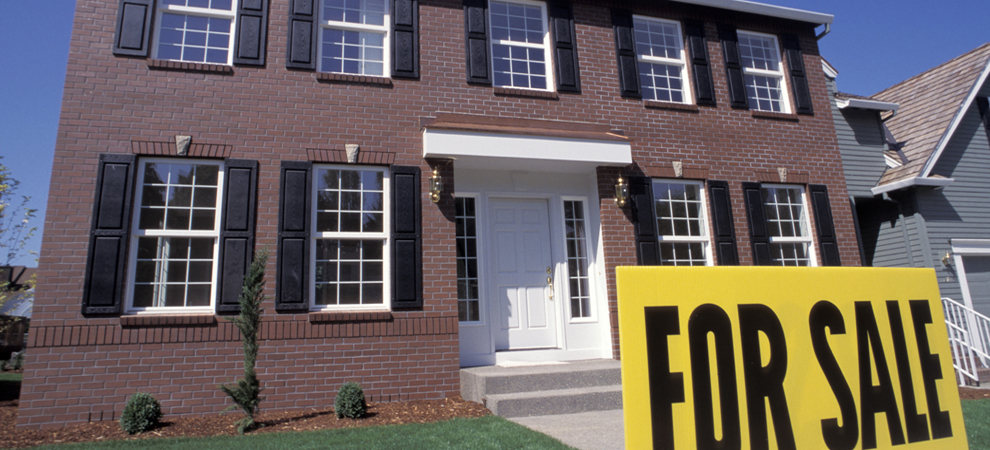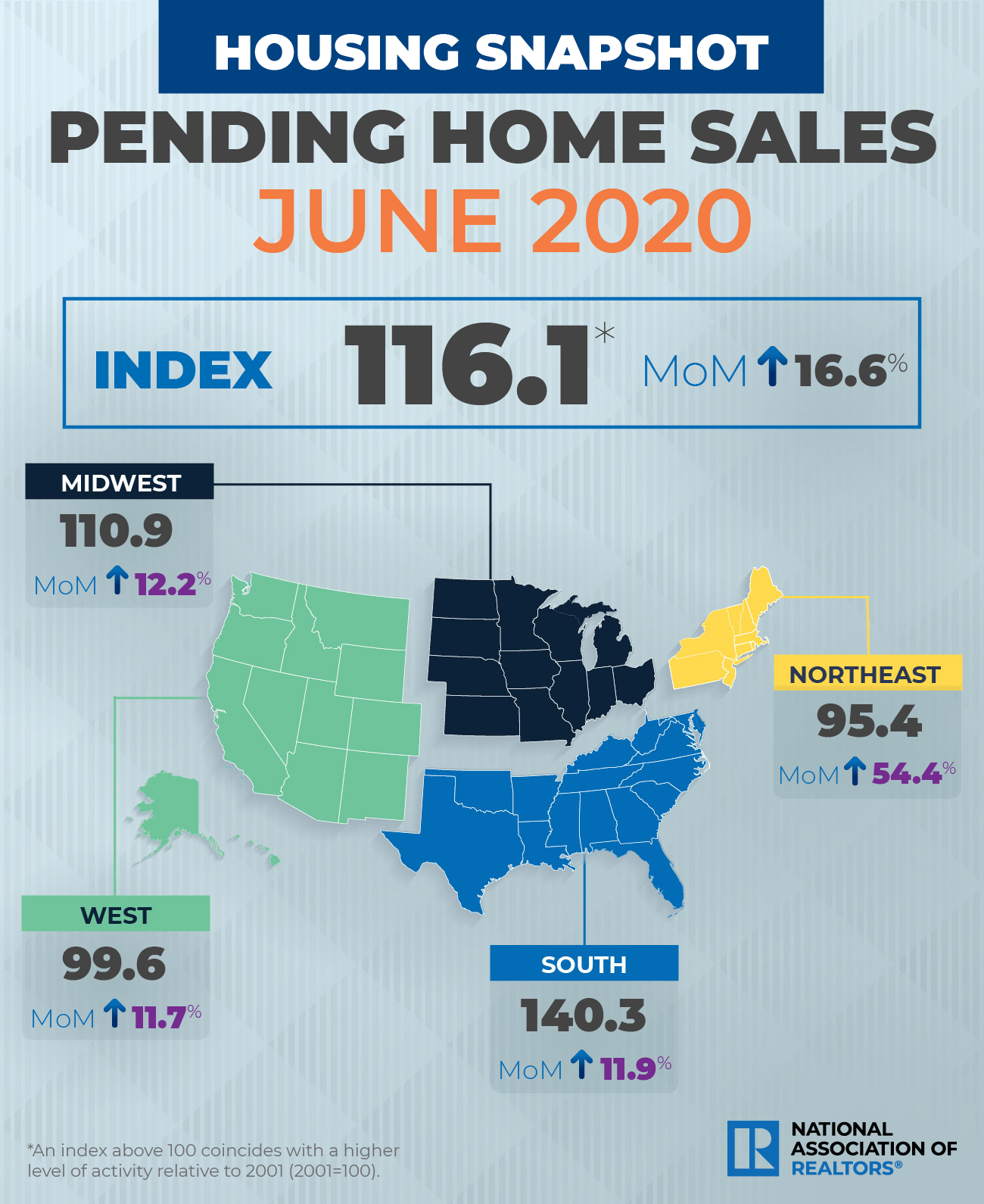The WPJ
THE WORLD PROPERTY JOURNALReal Estate Facts Not Fiction
Residential Real Estate News

Pending Home Sales Spike 16 Percent in June
Residential News » Washington D.C. Edition | By WPJ Staff | July 30, 2020 8:00 AM ET
According to the National Association of Realtors, pending home sales continued to ascend in June, 2020 sustaining two consecutive months of increases in contract activity.
Each of the four major regions experienced growth in month-over-month pending home sales transactions, while the Northeast was the only region to not record increases in year-over-year pending transactions.
The Pending Home Sales Index (PHSI), a forward-looking indicator of home sales based on contract signings, rose 16.6% to 116.1 in June. Year-over-year, contract signings rose 6.3%. An index of 100 is equal to the level of contract activity in 2001.
 "It is quite surprising and remarkable that, in the midst of a global pandemic, contract activity for home purchases is higher compared to one year ago," said Lawrence Yun, NAR's chief economist. "Consumers are taking advantage of record-low mortgage rates resulting from the Federal Reserve's maximum liquidity monetary policy."
"It is quite surprising and remarkable that, in the midst of a global pandemic, contract activity for home purchases is higher compared to one year ago," said Lawrence Yun, NAR's chief economist. "Consumers are taking advantage of record-low mortgage rates resulting from the Federal Reserve's maximum liquidity monetary policy."
In light of the apparent housing market turnaround, NAR has raised its forecast for the market. For all of 2020, existing-home sales are expected to decline by only 3%, with sales ramping up to 5.6 million by the fourth quarter. New home sales are projected to rise by 3%.
Yun expects that the positive GDP growth of 4% in 2021 will boost both existing and new home sales, which he forecasts to grow by 7% and 16%, respectively. Mortgage rates are anticipated to stay at near 3% over the next 18 months. Home prices will likely appreciate 4% in 2020, before moderating to 3% in 2021 as more new supply reaches the market, according to Yun.
June Pending Home Sales Regional Breakdown
The month of June saw each of the four regional indices rise on a month-over-month basis, marking two consecutive months of such gains.
The Northeast PHSI grew 54.4% to 95.4 in June, but was still down 0.9% from a year ago. In the Midwest, the index rose 12.2% to 110.9 last month, up 5.1% from June 2019.
Pending home sales in the South increased 11.9% to an index of 140.3 in June, up 10.3% from June 2019. The index in the West jumped 11.7% in June to 99.6, up 4.7% from a year ago.
"The Northeast's strong bounce back comes after a lengthier lockdown, while the South has consistently outperformed the rest of the country," Yun said. "These remarkable rebounds speak to exceptionally high buyer demand."
Yun says that as house hunters seek homes away from bigger cites - likely in an effort to avoid the coronavirus - properties that were once an afterthought for potential buyers are now growing in popularity.
According to data from realtor.com, metros with suburbs that most recently saw the highest gains in hotness rankings include Columbia, S.C.; Little Rock, Ark.; Greensboro, N.C.; Tulsa, Okla.; and Cape Coral, Fla.
"While the outlook is promising, sharply rising lumber prices are concerning," Yun said. "A reduction in tariffs - even if temporary - would help increase home building and thereby spur faster economic growth."
Each of the four major regions experienced growth in month-over-month pending home sales transactions, while the Northeast was the only region to not record increases in year-over-year pending transactions.
The Pending Home Sales Index (PHSI), a forward-looking indicator of home sales based on contract signings, rose 16.6% to 116.1 in June. Year-over-year, contract signings rose 6.3%. An index of 100 is equal to the level of contract activity in 2001.

Lawrence Yun
In light of the apparent housing market turnaround, NAR has raised its forecast for the market. For all of 2020, existing-home sales are expected to decline by only 3%, with sales ramping up to 5.6 million by the fourth quarter. New home sales are projected to rise by 3%.
Yun expects that the positive GDP growth of 4% in 2021 will boost both existing and new home sales, which he forecasts to grow by 7% and 16%, respectively. Mortgage rates are anticipated to stay at near 3% over the next 18 months. Home prices will likely appreciate 4% in 2020, before moderating to 3% in 2021 as more new supply reaches the market, according to Yun.
June Pending Home Sales Regional Breakdown
The month of June saw each of the four regional indices rise on a month-over-month basis, marking two consecutive months of such gains.
The Northeast PHSI grew 54.4% to 95.4 in June, but was still down 0.9% from a year ago. In the Midwest, the index rose 12.2% to 110.9 last month, up 5.1% from June 2019.
Pending home sales in the South increased 11.9% to an index of 140.3 in June, up 10.3% from June 2019. The index in the West jumped 11.7% in June to 99.6, up 4.7% from a year ago.
"The Northeast's strong bounce back comes after a lengthier lockdown, while the South has consistently outperformed the rest of the country," Yun said. "These remarkable rebounds speak to exceptionally high buyer demand."
Yun says that as house hunters seek homes away from bigger cites - likely in an effort to avoid the coronavirus - properties that were once an afterthought for potential buyers are now growing in popularity.
According to data from realtor.com, metros with suburbs that most recently saw the highest gains in hotness rankings include Columbia, S.C.; Little Rock, Ark.; Greensboro, N.C.; Tulsa, Okla.; and Cape Coral, Fla.
"While the outlook is promising, sharply rising lumber prices are concerning," Yun said. "A reduction in tariffs - even if temporary - would help increase home building and thereby spur faster economic growth."
Sign Up Free | The WPJ Weekly Newsletter
Relevant real estate news.
Actionable market intelligence.
Right to your inbox every week.
Real Estate Listings Showcase
Related News Stories
Residential Real Estate Headlines
- Las Vegas Area Home Prices Uptick 4.3 Percent Annually in March
- Single-Family Rent Growth in U.S. Trends Upward in 2025
- U.S. Mortgage Rates Tick Down Post Trump Tariffs Commencement
- President Trump's 'Liberation Day' Tariffs Potential Impact on the U.S. Housing and Mortgage Markets
- Baby Boomers Biggest Cohort of U.S. Home Buyers in 2025 as Millennials Decline
- U.S. Monthly Housing Payments Hit Record High in 2025
- U.S. Pending Home Sales Uptick in February
- Global Prime Residential Rent Slowdown Continued in Late 2024
- Ireland Home Price Inflation Hits 8 Year High in Early 2025
- Existing Home Sales in America Uptick in February
- Great Miami Area Residential Sales Decline 15 Percent Annually in February
- Mortgage Rates Uptick in Mid-March, Ending 9-Week Decline in U.S.
- World Property Ventures Builds the Future of Real Estate with New Funding Round
- U.S. Builder Sentiment Declines Amid Economic Uncertainty and Rising Costs
- Black Homeownership Rates in U.S. Enjoy Largest Annual Increase of All Racial Groups
- Wealthy Renters Are Taking Over More of the U.S. Rental Market
- If U.S. Congress Does Not Extend NFIP Soon, Thousands of Daily Home Closings Impacted
- U.S. Mortgage Applications Spike 11 Percent in Early March
- Greater Palm Beach Area Residential Sales Rise in Early 2025
- New Apartments in U.S. Are Leasing at Slowest Pace on Record
- U.S. Mortgage Rates Drop to 4 Month Low in March
- Overall U.S. Mortgage Delinquency Rates Dip in December
- New Tariffs on Canada, Mexico to Impact U.S. Homebuilder Input Costs
- Monaco's Property Market: A Tale of Two Cities
- U.S. Home Purchase Cancellations Surge, 1 in 7 Sales Getting Canceled
- U.S. Pending Home Sales Hit Historic Low in Early 2025
- Greater Miami Area Residential Sales Dip in January
- Governor DeSantis Supports Ending Property Taxes in Florida
- WPV Aims to Become the Berkshire Hathaway of Real Estate Tech
- U.S. Home Sales Slump Continues in January
- Average Americans Spend 38 Percent of Monthly Income on Mortgage Payments
- Switzerland's Safe-Haven Appeal Grows with World's Wealthy Homebuyers
- U.S. Builder Confidence Rapidly Declines in February
- Las Vegas Home Sales Rise 6.7 Percent Annually in January, Condo Sales Dip
- Homebuyer Demand in America Drops to 5-Year Low in Early 2025
- Ownership More Affordable Than Renting in Most U.S. Markets
- The World's First Global Listings Service Launches, Called a GLS
- Home Prices Continue to Rise in 89 Percent of U.S. Metros in Late 2024
- Global Luxury Residential Prices Showed Gradual Improvement in Late 2024
- U.S. Construction Hiring Rate Drops to Lowest Levels in 5 Years
Reader Poll
Marketplace Links
This website uses cookies to improve user experience. By using our website you consent in accordance with our Cookie Policy. Read More






